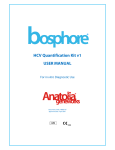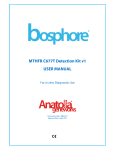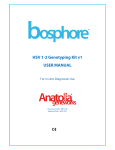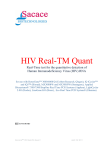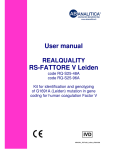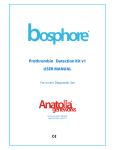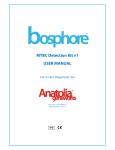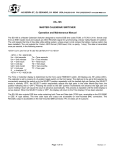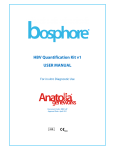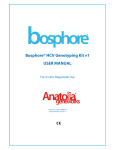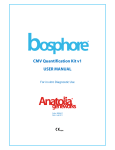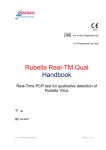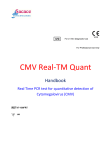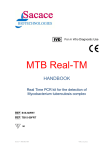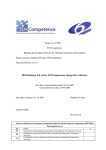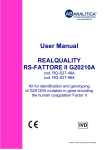Download FVL Detection Kit v1 USER MANUAL ®
Transcript
® FVL Detection Kit v1 USER MANUAL For in vitro Diagnostic Use ® Document Code: MB16v2f Approval Date: July 2011 Contents Page 1. Product Description 1 2. Content 1 3. Storage 1 4. Required Materials and Devices 1 5. Important Notes and Safety Instructions 2 6. Product Use Limitations 2 7. Mutation 2 8. Method 3 9. Procedure 4 9.1. DNA Isolation 4 9.2. Kit Components 4 9.2.1. PCR Mix 4 9.2.2. Detection Mix 1 4 9.2.3. Positive Control 4 9.3. Preparing the PCR 5 9.4. Programming the Montania® 483 Real-Time PCR Instrument 5 10. Analysis 8 11. Troubleshooting 9 12. References 9 13. Symbols 9 14. Contact Information 10 ii Code: MB16v1f Date: April 2011 1. PRODUCT DESCRIPTION Bosphore® FVL Detection Kit v1 detects Factor V Leiden mutation; namely G1691A (a change of glutamic acid to arginine) in human biological samples. Wild type F5 allele is amplified and fluorescence detection is accomplished using the HEX filter. Mutant F5 allele is amplified and fluorescence detection is accomplished using the FAM filter. 2. CONTENT Bosphore® FVL Detection Kit v1 is composed of Real-Time PCR reagents. Component 1 2 3 4 REAGENT dH2O PCR Mix Detection Mix1 Positive Control 100 Tests (1000 µl) (1375 µl) (110 µl) (44 µl) 50 Tests (1000 µl) (688 µl) (55 µl) (22 µl) 25 Tests (1000 µl) (344 µl) (28 µl) (15 µl) 3. STORAGE Bosphore® FVL Detection Kit v1 PCR reagents should be stored at -20°C. Repeated thawing and freezing (>3x) should be avoided since it may reduce sensitivity. If the components are to be used in small amounts, they should be frozen in aliquots. While preparing the PCR; the components should not be exposed to room temperature for more than 10 min and the detection mix components should not be exposed to light more than 12 min. We recommend preparing the PCR on a cooling block and keeping the detection mixes within a closed container. The components maintain their stability until the expiry dates on the labels, if they are stored at advised conditions. 4. REQUIRED MATERIALS AND DEVICES • Montania® 483 Real-Time PCR Instrument (Anatolia Geneworks), or another Real-Time PCR system with FAM and HEX filters (iCycler, iQ5, CFX–BioRad, LightCycler 1.5, 2.0, 480-Roche, 7500 Real-Time PCR System-ABI, Stratagene Mx3005P, Mx3000P-Agilent, LineGeneK, LineGene 9600-Bioer, Rotorgene 2000, 3000, 6000, Q-Qiagen) • 0.2 ml Thin-Wall PCR tubes or strips • Magnesia® 16 Nucleic Acid Extraction System / Magnesia® Genomic DNA Whole Blood Kit (Anatolia Geneworks),or other high quality genomic DNA extraction kits/systems • Deep freezer (-20°C) • Desktop centrifuge with rotor for 2 ml. microcentrifuge tubes 1 Code: MB16v1f Date: April 2011 • Calibrated adjustable micropipettes • DNAse, RNAse, pyrogen free micropipette tips with filters • DNAse, RNAse, pyrogen free 1.5 or 2 ml. microcentrifuge tubes • Disposable laboratory gloves 5. IMPORTANT NOTES AND SAFETY INSTRUCTIONS Important!: • The product should be delivered on dry ice. Check for presence of dry ice upon arrival. • Check for the expiry dates on the box and tube labels, upon arrival. Do not use expired products or components. • Calibrated or verified micropipettes, DNAse, RNAse, pyrogen free micropipette tips with filters, and DNAse, RNAse, pyrogen free microcentrifuge tubes should be used. • Before starting a test procedure, all components should be thoroughly thawed. After thawing, all components should be centrifuged briefly (spin-down for 3-5 seconds), and mixed well to ensure homogeneity prior to use. • The kit components should be kept on ice or a cooling block until the reaction is prepared, and they should be quickly returned to -20ºC. • PCR and nucleic acid isolation must be performed in different compartments. Samples should be stored separately to avoid contact with the kit components. • All the biological wastes produced during the nucleic acid isolation step; including the blood samples and material contacted with them, should be discarded into medical waste and disposed safely. 6. PRODUCT USE LIMITATIONS • All the components may exclusively be used for in vitro diagnostics. • This product should be used in accordance with this user manual. • This product is to be used by personnel specially trained to perform in vitro diagnostic procedures. 7. MUTATION Factor V Leiden is the name of the single base mutation in the gene (referred to as F5) for coagulation Factor V protein molecule. This mutation causes a missense substitution of glutamic acid for an arginine at amino acid 506 or 534 depending on the accepted start-position. Since this is the cleavage site for activated protein C (APC) to inactivate Factor V, this substitution prevents 2 Code: MB16v1f Date: April 2011 efficient inactivation of factor V (resistance to activated protein C) resulting in an increased tendency to form abnormal blood clots that causes hypercoagulability disorder (Thrombophilia). [1], [2] Factor V Leiden, which is the common inherited form of thrombophilia occurs in 3%-5% of the general population and in 20%-40% of patients with venous thromboembolic disease. The risk of blood clot mainly depends on if a person inherits one or two copies of the factor V Leiden mutation. Individuals inheriting one copy of the mutation (Heterozygous for the factor V Leiden defect ) have a 5-10 fold increased risk of thrombosis, while people inheriting two copies of the mutation (homozygous for the factor V Leiden defect), one from each parent, may have up to 50100 fold increased risk of developing this type of blood clot than wild-type (WT) healthy individuals. [3], [4] 8. METHOD Bosphore® FVL Detection Kit v1 is based on the Real-Time PCR method. Polymerase chain reaction is a technique that is used for amplification of a DNA region. The reaction occurs by the repeating cycles of heating and cooling. The main components of PCR are primers, dNTPs, Taq polymerase enzyme, buffer solution and template. Primers are small synthetic DNA those anneal to the specific regions of the template in order to start the synthesis. dNTPs are the building blocks of the amplified products. Taq polymerase amplifies the DNA template. Buffer solution provides the pH adjustment required for the reaction and template, as referred, is the target region for synthesis. In Real Time PCR technique, in contrast to conventional PCR, PCR product can be monitored during the reaction. Therefore, Real-Time PCR obviates the need for further analysis methods like gel electrophoresis, whereby minimizing the risk of contamination. Dual-labeled probes employed in the reaction in addition to the conventional PCR reagents, enable detection of the amplified target with increased sensitivity. The test utilizes the 5’ exonuclease activity of Taq Polymerase to cleave a dual-labeled fluorescent hydrolysis probe during the extension phase. The probe is labeled at the 5’ end with a fluorescent reporter, and at the 3’end with another fluorescent molecule that acts as a quencher for the reporter. When the two fluorophores are in close proximity, even if the reporter is excited by light, no reporter fluorescence can be detected. During the elongation step, Taq Polymerase encounters and cleaves the probe bound to the template. As the reporter is relieved from the suppressing effect of the quencher, fluorescence signal can be detected. 3 Code: MB16v1f Date: April 2011 As the PCR product accumulates, the fluorescence generated by the reporter increases. The point at which the signal rises above background level and becomes detectable, is called the threshold cycle (CT). Bosphore FVL Detection Kit v1 employs multiplex PCR. F5 DNA, whether wild-type or mutant, is amplified in a single reaction, using sequence-specific primers against mutant and wild-type alleles. The fluorescent signal generated by the mutant-type F5 gene amplification is detected by a probe labeled at the 5’ end with FAM, through the FAM channel. In contrast, the fluorescent signal generated by the wild-type allele amplification, is detected by a second probe (labeled at the 5’ end with a different reporter molecule, HEX) through the HEX channel. 9. PROCEDURE 9.1. DNA Isolation We recommend that the Magnesia® 16 Nucleic Acid Extraction System / Magnesia® Genomic DNA Whole Blood Kit (Anatolia Geneworks) isolation system is used with Bosphore® FVL Detection Kit v1. The DNA isolation should be performed according to the manufacturers’ instructions. The starting volume is 400 µl; the elution volume is 60 µl. 9.2. Kit Components 9.2.1. PCR Mix HotStarTaq DNA Polymerase: HotStarTaq DNA Polymerase is a modified form of a recombinant 94 kDa DNA polymerase, originally isolated from Thermus aquaticus, cloned into E.Coli. The enzyme is provided in an inactive form. It is activated by a 15-minute 95 ºC incubation step. This prevents the formation of misprimed products and primer-dimers during reaction setup and the first denaturation step, leading to high PCR specificity and accurate quantification. PCR Buffer: contains Tris-Cl, KCl, (NH4)2SO4, 8 mM MgCl2, pH 8.7 (20ºC ). dNTP Mix: Contains ultrapure quality dATP, dGTP, dCTP ve dTTP/dUTP. 9.2.2. Detection Mix 1 Detection Mix 1 contains F5 gene -specific forward and reverse primers (10 µM each) and two dual-labeled probes against wild-type and mutant F5 allele (1.5 µM each). 9.2.3. Positive Control The positive control contains heterozygous F5 gene containing one copy of the wild-type and mutant F5 allele each. It should be included in the PCR to efficiently test whether the samples being analyzed are positive or negative. The threshold cycle for the positive control is given in the acceptance criteria table (Section 10. Analysis). Threshold cycles higher than the acceptance criteria may indicate an efficiency loss in the reaction. 4 Code: MB16v1f Date: April 2011 9.3. Preparing the PCR Positive control should be added into the PCR reaction together with the samples and the negative control (PCR-grade water). Make sure that all the kit components are thawed before use. Refer to the table below for preparing the PCR. It is for only one reaction, multiply these values with the sample number to find the values required for the master mix. While preparing master mixes for more than 3 samples, an extra 10% should be added to the total sample number. PCR Mix Detection Mix 1 dH2O Sample DNA Positive/Negative Control 12.5 µl 1.15 µl 6.35 µl Toplam Hacim 25.0 µl 5 µl Pipette 20 µl of the master mix into the PCR tubes or strips, and add 5 µl of DNA (sample/positive or negative control). Close the tube cap. Make sure that the solution in each tube is at the bottom of the tube. Centrifuge if necessary. 9.4. Programming the Montania® 483 Real-Time PCR Instrument The thermal protocol for Bosphore® FVL Detection Kit v1 is composed of an initial denaturation for activation the HotStarTaq DNA Polymerase, a two-step amplification cycle and a terminal hold. The real-time data is collected at the second step of the amplification cycle. Initial denaturation Denaturation Annealing and Synthesis (Data Collection) Hold 95°C 95°C 64°C 14:30 min. 00:30 min. 00:45 min. 22°C 05:00 min. 35 cycles Montania® 483 Real-Time PCR Instrument is installed and calibrated as it is delivered to the end user. In order to establish an appropriate link between the system components, first the thermal cycler and the optical module, and then the PC and the software should be started. Before starting a Real-Time PCR reaction using the Bosphore® Kits, the following steps should be completed: • Choose the filter pairs to be used (FAM and HEX), • Identify unknown samples, positive and negative controls, • Select the correct thermal protocol. 5 Code: MB16v1f Date: April 2011 These steps are described below: From the main menu of the Montania® 483 Real-Time PCR Instrument, “File” and then “New” is selected. “Create a new Experiment” is selected. In the “Select Channel” window channels 1 (FAM) and 2 (HEX) are selected (Fig. 1). Samples, positive and negative controls are identified in the “Module Edit” menu (Fig. 2). To select the thermal protocol “Gene Amplification” menu is used. The “Open” button in the “Experiment Program” is clicked and the appropriate thermal protocol is selected. (Fig. 3a). The thermal cycles of the selected protocol is displayed. The experiment starts by clicking the “Start” button (Fig. 3b). Fig. 1: Filter Selection in Montania® 483 Fig. 2: Sample Location and Identification 6 Code: MB16v1f Date: April 2011 Fig. 3a: Selecting the Thermal Protocol Fig. 3b: Starting the Experiment 10. ANALYSIS By the end of the thermal protocol, the Montania® 483 Real-Time PCR Instrument software automatically calculates the baseline cycles and the threshold. Example of an amplification curve is given in Fig. 4. 7 Code: MB16v1f Date: April 2011 Fig. 4: Amplification Curve of a Bosphore® FVL Detection v1 test Analysis of the results should be performed by trained personnel who have received the required training for analyzing Real-Time PCR data. We recommend that the test results must be evaluated by an expert clinician, taking the patient’s clinical findings and the results of other tests into consideration. The non-exponential signals that cut the threshold in the last 5 cycles, and with a Rn lower than 0.2 should not be considered as a positive amplification. Please consult the manufacturer in case of problems with analyzing the results. All analysis is done automatically in routine use. However, when the trained personnel, who have received the required training from manufacturer, consider it as necessary, the system allows pulling down the threshold as much as possible in order to detect slight amplifications. In this case, attention should be paid to keep the threshold line above the background. Amplification should be observed from both FAM and HEX filters of the heterozygous positive control during the test. The amplification of both filters from the tested samples should be compared with that of the positive control. Test results should not be reported unless the assay results meet the criteria stated above. Please contact the manufacturer if an impairment in the product’s performance is observed (See the last page for contact information). The qualitative results of the test are displayed on the “Report Mode” screen. The samples that cross the threshold in Channel 1 (FAM) and Channel 2 (HEX) are displayed as positive, for mutant and wild-type alleles respectively. The following table shows the possible results and their interpretation: 8 Code: MB16v1f Date: April 2011 Signal in both FAM and HEX No signal in FAM, signal in HEX Signal detected only in the FAM filter No signal in FAM and HEX Heterozygous mutant: The sample has both wild-type and mutant F5 alleles. Homozygous wild-type: The sample has only wild-type FV DNA Homozygous mutant: The FV DNA in the sample is composed of mutant alleles The test should be repeated 11. TROUBLESHOOTING Please contact the manufacturer in case of a problem during a run. Signal from FAM/HEX Filter in the Negative Control Contamination Use filter-tips. Repeat PCR with new kit components. The Threshold is Above Low Signals The threshold should be manually Using the mouse pull the threshold down until it cuts the low adjusted signals. Avoid the background and the signal from negative control. 13. REFERENCES 1. Bertina, R.M., et al., Mutation in blood coagulation factor V associated with resistance to activated protein C. Nature, 1994. 369(6475): p. 64-7. 2. Genetic home reference, NIH Resources, Factor V Leiden thrombophilia, August 2010 3. Herrmann, Koesling, et al., Prevalence of factor V Leiden mutation in various populations. Genet. Epidemiology, 1997. 14(4): p. 403-411. 4. Epidemiology: Rees DC, Cox M, Clegg JB. World distribution of Factor V Leiden. Lancet 1995;346:1133–4 14. SYMBOLS Use by Lot/Batch REF Catalog number Temperature limitation Caution, consult accompanying documents Manufacturer IVD In Vitro Diagnostic Medical Device 9 Code: MB16v1f Date: April 2011 15. CONTACT INFORMATION ® Anatolia Tanı ve Biyoteknoloji A.Ş. Egitim Mh. Kasap Ismail Sk. No:10/23 Kadikoy 34722 ISTANBUL-TURKEY Phone: +90 216 330 04 55 Fax: +90 216 330 00 42 E-mail: [email protected] www.anatoliageneworks.com Registered Trademarks: Anatolia Geneworks® Montania®, Magnesia® and Bosphore® are registered trademarks of Anatolia Tani ve Biyoteknoloji Inc. 10 Code: MB16v1f Date: April 2011












